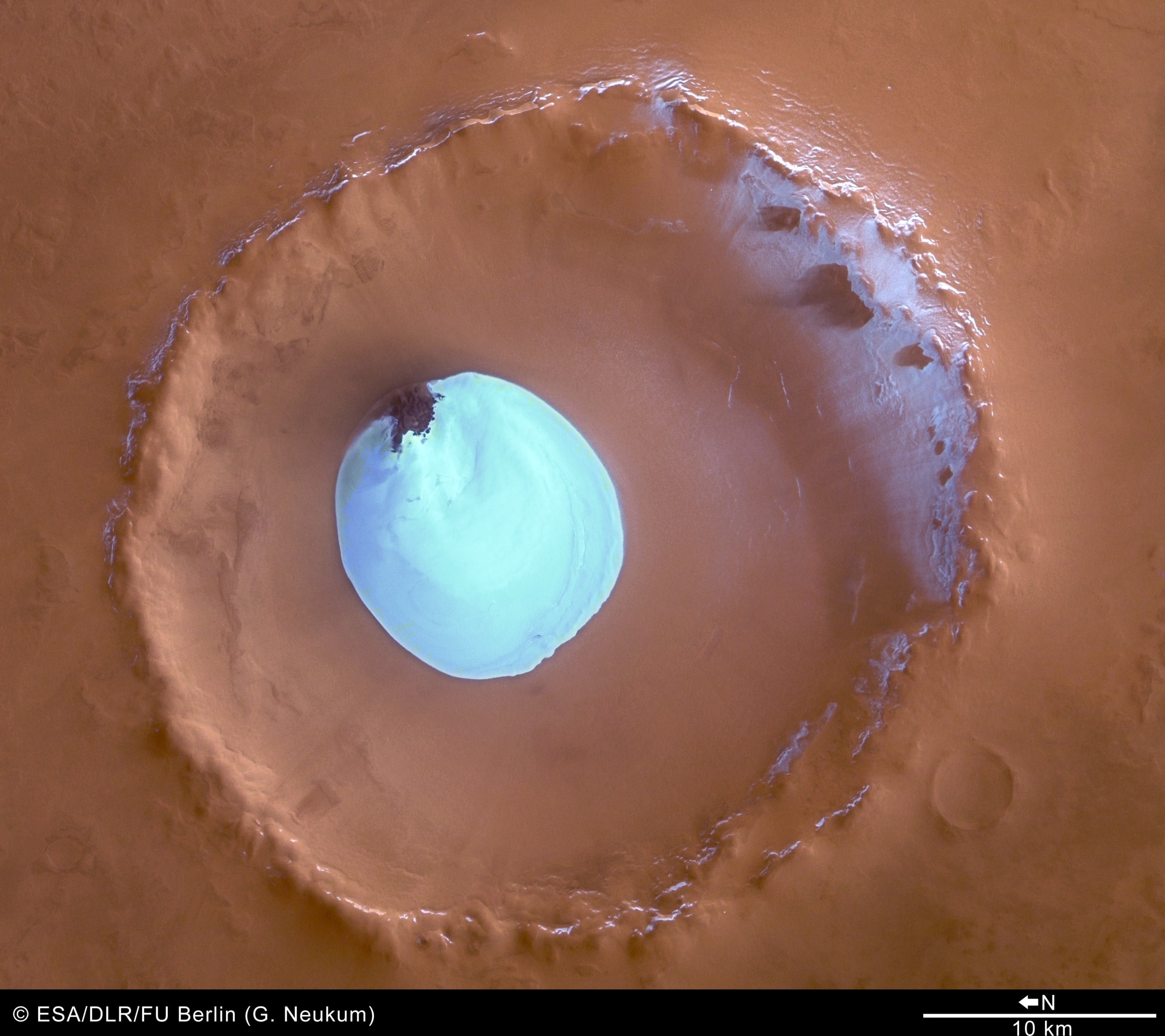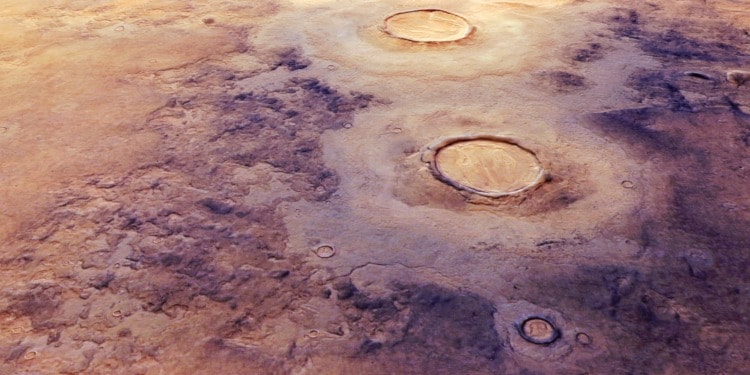Around 3.7 billion years ago, Earth, a young planet in the early days of existence, supported the first signs of life in the form of single-cell microbial organisms known as archaea. One step further away from the sun, on Mars, astrobiologists now believe that ancient alien microbial life could have started in a similar way – at roughly the same time.
Fast forward a few billion years though, and the difference between life on the neighboring red and blue planets is stark.
Life on Earth has evolved enormously since the first archaea colonized the oceans, thriving to unsustainable new levels, triggering global warming on an unprecedented scale.
On dusty, cold and desolate Mars however – signs of past or present life are being explored but unconfirmed.
A new astrobiological climate model, published in Nature Astronomy, not only now finds that the ancient Martian surface was possibly habitable for early microbial life, but also that the present-day disparity between Earth and the Red Planet could in fact be because Martian life has already triggered its own extinction.
What’s more, the astrobiologists behind the study believe their extinction could have been caused by self-induced climate change on Mars – just much earlier, and in reverse.
A calculation based on a state-of-the-art climatic-ecological model shows a high likelihood of a biosphere of methanogens on the surface/subsurface of early Mars. Methane production might have even contributed to Mars' global cooling. @BorisSauterey et al: https://t.co/LlrYbYBbED pic.twitter.com/JhWxpjHr2q
— Nature Astronomy (@NatureAstronomy) October 10, 2022
In the first of its kind, this study, conducted by astrobiologists from the Institut de Biologie de l’Ecole Normale Supérieure in Paris, aimed to demonstrate how early microbes might have survived on ancient Mars, and simulate how their existence and “biological feedback” might have affected the Red Planet’s atmosphere and climate.
Much like the global warming we now experience on Earth, the group’s theory is that the reverse might have happened long ago on Mars, with ancient microbial life causing irreversible changes to the climate on the Red Planet, sparking an event known as global cooling.
As the microbes’ existence gradually destroyed the planet’s natural defenses, a self-perpetuating spiral may have been eventually triggered, ultimately rendering the environment unlivable and completely wiping out their existence – sounding scarily familiar?
Early life on the Red Planet
The Parisian group’s simulation shows that, similarly to Earth, in the early days of Mars’ existence some 3.7 billion years ago, the planet is likely to have been home to ancient microbial organisms that consumed elements from the atmosphere as an energy source.
Along with many other astrobiologists, they hypothesize that Mars’ “regolith” surface in its early geological period would have been sand-like, porous and brine-saturated in nature, possibly providing a “favorable environment for microbial life… sheltered from ultraviolet and cosmic radiation.”

“We find that subsurface habitability was very likely,” says the group, and could have even been as high as within Earth’s primordial oceans.
“At that time, Mars would have been relatively wet and relatively warm,” said the lead author of the study, Boris Sauterey. “It had liquid water in the form of rivers, lakes and maybe oceans on its surface,” and would have been “between minus 10°C and 20°C.”
Why did life survive and evolve on Earth, but not on Mars?
The bottom line is that 1) Mars’ atmosphere is composed differently, and 2) it’s further away from the sun.
It’s thought that the primordial beings, known as methanogens, on both neighboring planets, Earth and Mars, lived off of H2 and CO2 within the atmosphere, producing methane as a waste product – much like all living organisms do, including humans, cows and mushrooms.
On Earth, methane is a potent greenhouse gas that keeps the planet warm, so the build up of the early microbes’ waste products helped to create a cozy, life-sustaining environment that allowed themselves, and gradually more complex life forms, to survive, thrive and evolve.
Mars’ atmosphere was similarly composed of a dense abundance of potent greenhouse gasses, but instead of methane, it was predominantly composed of carbon dioxide and hydrogen – the very elements these microbes were living off.
Related Articles: Aliens on Mars? NASA Discovers Signs of Ancient Life | NASA’s Return to the Moon on Hold | Space Cooperation with Russia in Jeopardy | NASA Dart Test Could Save Earth
Being further away from the Sun, Mars is also naturally cooler, and so relied more heavily on its greenhouse gas layer to maintain a life-comfortable surface temperature.
Therefore, as the single-cell organisms began multiplying and devouring more carbon dioxide and hydrogen as they grew in numbers – they also began eating away at the only protective blanket they had against the elements.
The group’s simulation revealed how holes might have begun to appear in Mars’ greenhouse gas layer, and the methane the microbes produced in its place was unfortunately not as potent, meaning the planetary warming effect was gradually diminished.
As a result, ancient Mars began to cool dramatically, with the surface temperature dropping to lows of -60°C, and much of the groundwater turning to ice – a global cooling event that would have forced the biosphere to burrow “deep into the Martian crust” in search of warmer conditions.
As the planet cooled further, the microbes’ underground life had to keep getting deeper, in some places reaching depths of up to one kilometer beneath the Martian surface; but whether or not any microbes remain there to this day is a question unanswered at present.

Is the existence of life random?
The astrobiologists believe their findings support two main ideas. First, that Mars was once, and may still be, a habitable environment for life-forming organisms, and second that, though life may sprout in other parts of the solar system, its ability to maintain “habitable conditions on the surface of the planet” might not be as simple as it sounds.
They explore the idea that life might not always be self-sustaining, and that if the delicate, complex and finely-tuned balance of existence is lost – the scales can easily tip towards extinction rather than evolution.
“The ingredients of life are everywhere in the universe,” says Sauterey, “so it’s possible that life appears regularly.”
The possible problem, the group believes, is that just because life is able to form on a planet or in an environment, doesn’t mean it is able to persist.
Sauterey says his group took this concept another step further, showing that even very primitive life could have “a completely self-destructive effect.”
What’s next?
Despite their findings on the past habitability of Mars, the group are dubious as to whether life might still exist there, stating that due to the shifting atmosphere on Mars, the microbes might have had to switch to an alternative energy source.
They are however keen to validate their theories by finding hard evidence on the Red Planet, and hope that their model could act as a compass, providing insight into which geographical regions could be pinpointed as ideal places to search for signs of past alien life.
The group estimates that the best places to start would be in areas where organisms are able to be close to the planetary surface so that they have access to energy sources, but are also sheltered from the inhospitable temperatures of the Martian atmosphere.
One of the places they suggest is NASA’s Jezero Crater. “The warmest places are usually the deepest places,” says Sauterey.
Explore one of the most detailed views ever returned from the Martian surface! Journey alongside @NASAPersevere in Jezero Crater, one of the best places on Mars to search for signs of ancient life. pic.twitter.com/PZhEEJviDS
— NASA JPL (@NASAJPL) September 14, 2022
Due to its cavernous landscape, the crater and current excavation site of NASA’s six-wheeled robot geologist – the Perseverance rover – is a possible ancient microbial hotspot, according to the group.
Sauterey explains that “at the bottom of these craters and valleys, the climate is much warmer than on the rest of the surface and that’s why it would be much easier to search there for evidence of these life forms.”
NASA’s science chief, Thomas Zurbuchen, also previously said that the Jezero Crater is one of the “best locations on Mars to look for signs of past microscopic life.”
Signs of ancient microbial life on Mars are stacking up
For over a decade, NASA have explored the surface of Mars with their Curiosity rover, searching the landscape for answers to a monumental question: Could Mars have supported ancient life?
The rover, as well as satellites orbiting the Red Planet, have previously been able to detect methane on the planet’s surface, as a first indication that methane-producing life might be present there.
Last month though, the space agency got a more concrete answer to their extraterrestrial question, as NASA’s Perseverance rover uncovered evidence of the “chemical building blocks of life” – carbon, hydrogen, oxygen, nitrogen, phosphorus, and sulfur – within rock core samples from the crater, possibly serving as the first “biosignatures” of ancient alien microbial life.
Layer upon layer of rock, like pages in a Martian history book, waiting to be read. The right samples from this area could give us insights like we’ve never seen. I’m getting out my coring drill.
Latest images: https://t.co/Ex1QDo3eC2 pic.twitter.com/1oI31TwIVW
— ARCHIVED – NASA's Perseverance Mars Rover (@NASAPersevere) July 7, 2022
Aside from this latest simulation providing a window into the possible past life on Mars where ancient alien microbes met their demise through their own cycle of consumption, the study also provides a glimpse into the possible future on Earth – as we continue to fuel global warming and threaten ourselves with the same fate.
There is however still hope, as NASA’s recent biosignature discoveries could indicate that life on Mars still exists.
If Martian microbes can resist and persist climate change, then hopefully humans can too. But, rather than dealing with the fallout, or having to move our lives 1km underground, wouldn’t it be easier to step-up and take action to adapt our lifestyles, mitigate more damage, and reduce our climate impact – before it’s too late?
Editor’s Note: The opinions expressed here by the authors are their own, not those of Impakter.com — In the Featured Photo: Perspective view of Utopia Planitia on Mars. Featured Photo Credit:ESA/DLR/FU Berlin, CC BY-SA 3.0 IGO













